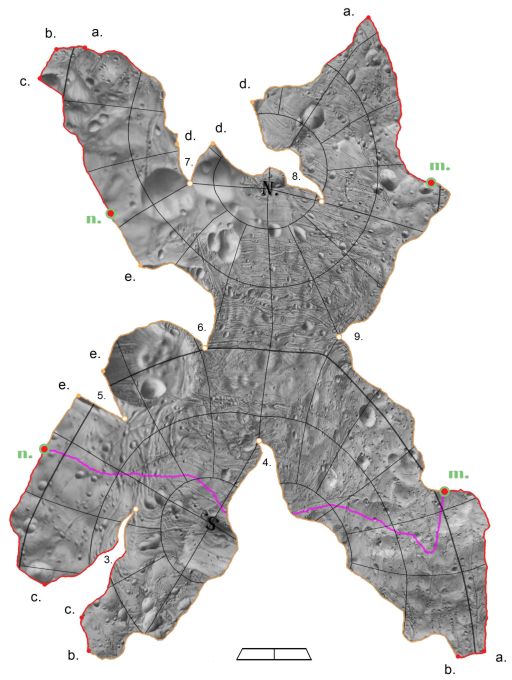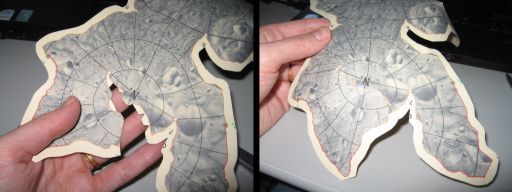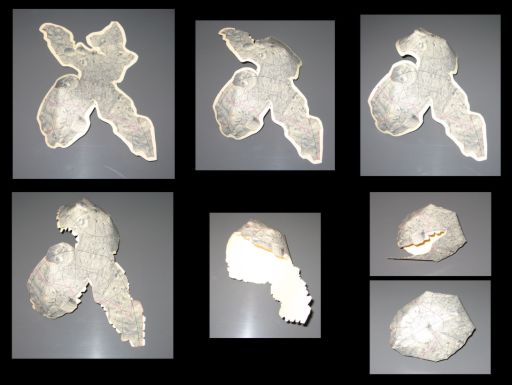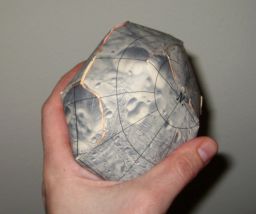Emily Lakdawalla • Mar 05, 2008
Phobos arts and crafts
A Georgia architect named Chuck Clark has been experimenting for several years with a technique called "Constant Scale Natural Boundary Mapping," a geometric method for making a two-dimensional map of a three-dimensional object that can be cut and folded into a reasonable representation of the actual thing. He'll be presenting his Phobos and Deimos maps (PDF, 650k), and his method, in a poster at the Lunar and Planetary Science Conference next week. He recently posted a new constant scale natural boundary map of Mars' moon Phobos, and I thought I'd give the assembly a try. Here's the map, which I printed onto a letter-sized piece of card stock:

Chuck Clark / Phobos base image by USGS
Constant-scale natural boundary map of Phobos
This map of Phobos can be cut out and assembled into a good three-dimensional representation of the odd-shaped moon of Mars. The map was produced through a technique called constant-scale natural boundary mapping, developed by Georgia architect Chuck Clark.- Cut out the map, leaving about a quarter inch (5 mm) of paper around all the edges.
- You will need to cut off most of this extra paper, but leave tabs as necessary so that you can glue or tape the edges together. Generally, it's best to leave a tab on the concave side of a seam, and cut off the paper on the convex side of a seam.
- To help things fold flat, you need to snip notches into your tabs, making no tab longer than about 1/2 inch (1 cm) along the seam. If you're familiar with sewing, this is usually referred to as "clipping curves."
- Start gluing together the seams. I started in the narrowest notches first, applying a little white glue to a tab and bringing the other side over and squeezing it together for 10 seconds or so with thumb and forefinger, then I applied some transparent tape on the back side for good measure.
- You'll have to strategize about where your last seam is going to be, since you'll no longer be able to get a finger inside the model to apply counterpressure. I found it easiest to make the last seam one of the pretty straight ones.
- Chuck Clark actually seems to assemble these without glue, just using a little tape here and there across the seams. To join the last seam, he recommends a narrow rod or straw be inserted through a gap antipodal to the spot you need to tape, to allow you to apply counterpressure.

ESA / DLR / FU Berlin (G. Neukum)
Phobos
Phobos is likely a captured asteroid and is a tiny object measuring only 27 x 22 x 19 kilometers (17 x 13 x 12 miles) in size. The pixel scale of the enlarged view of this moon is only 7 meters (20 feet), nearly the highest ever achieved; and with the sharp vision of Mars Express' High Resolution Stereo Camera, the details are sharper in this image than in any previous one. The huge crater to the left side is named Stickney.In the photo below, I've rotated my glued-together model to match the viewing geometry. My thumb sort of traces out the terminator (day-night boundary) -- there's quite a bit of Phobos that we can't see in the Mars Express image because it was night there when the photo was taken. This totally does not match the mental model I had for the photo -- I'm going to have to try to keep my Phobos model from getting crushed and pull it out every time I see a new image!
Support our core enterprises
Your support powers our mission to explore worlds, find life, and defend Earth. You make all the difference when you make a gift. Give today!
Donate

 Explore Worlds
Explore Worlds Find Life
Find Life Defend Earth
Defend Earth




